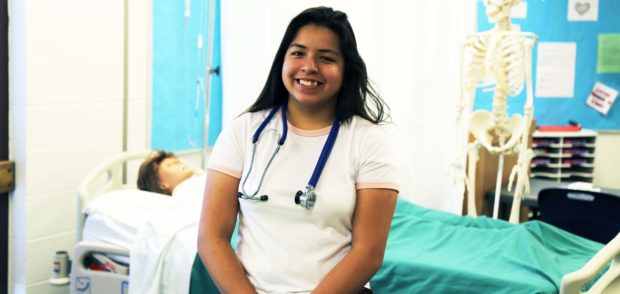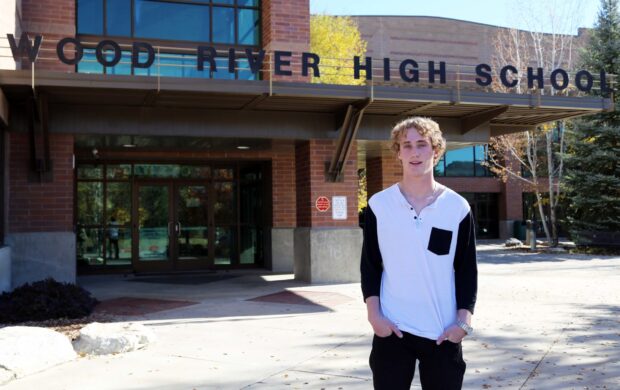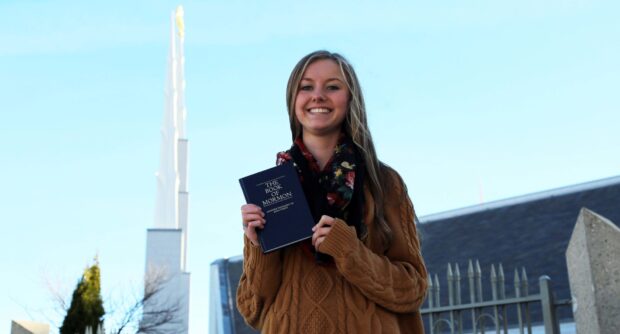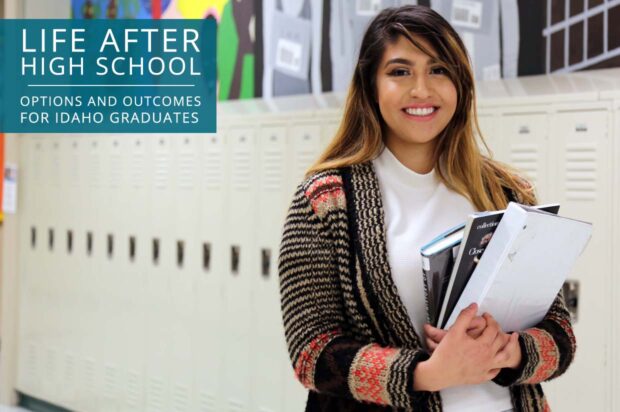Idaho public policy encourages high school graduates to attend college.
The state pays for high school students to take college-level classes and college placement tests. Across the state, newly hired counselors help students consider their options, including college.
But the decisions of young adults don’t hinge on policies. Decisions come down to personal preference.
Today, five students talk about their plans — affected somewhat by state policy, but affected more by their personal histories.
Kim Aranda
- Wood River High School senior
- Interested in art and environmental science
- Hopes to attend a private, four-year college
Kim is applying to a dozen colleges. Her first choice is to attend two — she wants to study environmental science at Brown University, an Ivy League school in Providence, R.I., and study at the Rhode Island School of Design.
Tragedy and adversity have posed challenges. When Kim was in seventh grade, her mother died. Her father, an immigrant from Peru, did not graduate from high school. Kim had a GPA of 2.6 in middle school. As she plans to become a first-generation college student, Kim is striving for a high school GPA topping 4.0.
Kim has gotten help along the way — beyond the help Idaho students can access at school. Leadership Enterprise for a Diverse America, a nonprofit that helps disadvantaged students compete for spots in prestigious colleges, selected Kim for a fellowship last summer. During seven weeks of training at Princeton University, Kim received guidance in the college application process.
She also got help in preparing for the SAT. Like more than 19,000 other high school juniors, Kim participated in Idaho’s state-funded “SAT Day” in April. But Kim couldn’t afford SAT guidebooks, and she didn’t get the score she wanted on the college entrance exam. LEDA gave Kim the chance to prepare for a retake, and helped her get a waiver on test costs. This fall, she improved her score by 100 points, a significant boost on the SAT’s 1,600-point scale.
Kim is taking five Advanced Placement classes during senior year. A demanding AP studio art class will require her to complete 24 pieces in media ranging from oil painting to sculpture. Her portfolio focuses on environmental topics. One piece is a large clear cube — partially melted, to depict global warming.
Since Kim helps her father around the house, she says it’s hard to carve out time for AP coursework. But she also says she gets her inspiration from her father, who comes home from his construction job every night, covered in paint and sweat but able to joke around with his four kids.
“He’s busting his back every day,” she said.
Itzel Chavez
- Wood River High School senior
- Interested in becoming a surgical technician
- Plans to attend two-year college
For as long as Itzel can remember, her mother has battled health problems. Years ago, Itzel promised her mother that she would help her by pursuing a career in a medical profession.
“Ever since that day, I have been committed to this,” she said
Working toward that goal, and fulfilling that promise, hasn’t always been easy. Itzel started taking medical-technical classes as a sophomore. A certified nursing assistant’s class could earn her some college credit this year. But as a junior, she struggled to get through a medical terminology class.
That’s the risk that goes with dual-credit classes. When students do well, they earn college credits and the state pays the bills. When students struggle, they might decide college isn’t for them.
“You do kind of test your grit and your guts a little bit,” said Liz Clark, a career and college transition coordinator in the Blaine County schools. “Not every student has the wherewithal that Itzel has.”
Clark is a recent hire in Blaine County schools. Her salary comes from the district’s share of counseling dollars, a $5 million state line item approved in 2016.
Clark has helped Itzel set up college tours and narrow down her options; Itzel’s first choice is Salt Lake Community College in Utah. Clark has also counseled Itzel’s parents — who had never gone to college, and struggled with the mandatory and intimidating Free Application for Federal Student Aid. “They were all lost on FAFSA,” Itzel said.
Ryan Yearous
- Nampa High School junior
- Interested in kinesiology
- Hopes to attend college
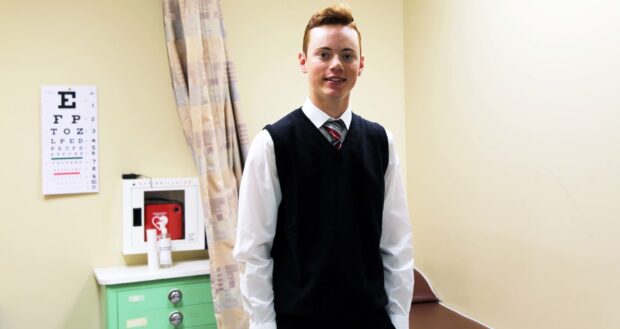
Ryan’s five dual credit classes include a menu of career-technical classes and an Advanced Placement U.S. history class.
“I feel like I’m already a college student,” he says.
His goal isn’t just to prepare for the rigors of college; he also hopes to obtain skills that will get him a higher paying job as he works his way through college.
Ryan’s career-technical classes focus on health care, and this year it is his turn to take medical terminology. After high school, he hopes to get a job in emergency medical services, or get his certification as a personal trainer. Either job path could help him pay for college.
He says he is lucky to have $4,125 of state money to pay for career-technical classes and AP courses — and he knows that, for some of his classmates, the money makes the difference between taking some college-level classes and none at all.
But he admits it’s a challenge to juggle a full slate of dual credit classes, including an AP class that requires more reading and analysis.
“It’s definitely tough at times, but I definitely feel like I learn way more.”
Elijah Silvia
- Wood River High School senior
- Interested in working in his family’s roofing business
- Does not plan to attend to college
Elijah remembers the Great Recession, even though he was a grade-school student at the time. His family’s business felt the effects, but it was “liveable.” When Blaine County’s housing market flourishes, the company does well.
After graduation, Elijah expects to put money toward a house and a car — instead of college, “where it’s not really guaranteed that you’ll get it back.”
Elijah’s plans don’t align with Idaho’s goal of getting 60 percent of young adults to obtain a college degree or certificate. Clark, one of Blaine County’s counselors, sees Elijah’s story differently. He is doing the one thing she preaches; he’s making his own decision, and putting thought into it.
“He’s going to be making great money for an 18-year-old,” she said.
Elijah says he never was interested in school, and at 13, he got kicked out. He remembers his father’s advice. School is easy. Work is hard.
His father was right, but Elijah says he has no regrets about his plans.
As graduation approaches, Elijah feels disconnected from school. Like his classmates, he is working on his senior project — even though he says it will do nothing to prepare him for his job.
Elijah says he did study for the SAT his junior year, because he wanted to see what he’d learned. But he is skeptical about SAT Day. “To try to push that onto everyone is not a good thing.”
Madison Wilhelm
- Borah High School senior
- Interested in music education
- Plans to attend college after a church mission
Two of Madison’s biggest life decisions were made years ago.
She has long planned to attend college. In junior high school, she decided she would first serve on a mission for The Church of Jesus Christ of Latter-Day Saints. Madison says the church has been a source of “happiness and joy” in her life, and she wants to spend two years introducing other people to her faith.
Madison will join thousands of Idaho students who will serve church missions after they finish high school. Church missions contribute to the state’s low college go-on rates — particularly in Eastern Idaho, where the Mormon Church is the region’s predominant religion.
The long-range question: Do returning missionaries pick up their education after they serve their church?
Madison doesn’t expect to be sidetracked.
She knows college will be two years’ more expensive by the time she enrolls. But she has made Utah State University her top choice, with money in mind. She believes she can get more scholarships there, even as an out-of-state student, and hopes to use aid and work earnings to limit her student loan debt.
She also knows she would be returning to school after a two-year hiatus. However, she has heard from other former missionaries, who say the rigors of mission translate well to going back to the classroom.
Madison has used her advanced opportunities money to take dual-credit classes in Spanish, health and pre-calculus. She feels like she knows what awaits after her mission. “Without those classes I might not know how hard college is going to be.”
About this series
In “Life After High School: Options And Outcomes for Idaho Graduates,” Idaho Education News takes an in-depth look at the state’s “60 percent goal.” Why is Idaho still struggling to convince high school graduates to continue their education? We look at the policies that shape this issue — and talk to students about their plans and the personal decisions.
Here’s the series at a glance:
Day One. After five years and $100 million, Idaho remains far from its ’60 percent goal’
Day Two. A defining decision: Five high school students talk about their plans
Day Three. As Idaho tries to sell the value of college, the sticker price keeps rising
Day Four. It will take even more time and money to reach Idaho’s ’60 percent goal’


